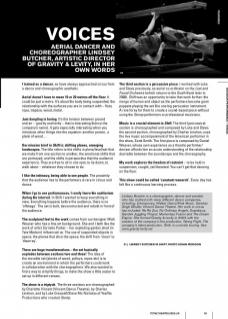I trained as a dancer, so have always approached circus from a dance and choreographic aesthetic.
Aerial doesn’t have to mean 10 or 20 metres off the floor. It could be just a metre. It’s about the body being suspended; the relationship with the surfaces you are in contact with – floor, rope, trapeze, wood, metal.
Just dangling is boring. It’s the tension between ground and air – gravity and levity – that is interesting (hence the company’s name). It gets especially interesting when you introduce other things into the equation: another person, a plank of wood…
Our mission brief in Shift is: shifting planes, emerging landscapes. The title refers to the shifts in plane/level/set that we make from one section to another, the emotional shifts that are portrayed, and the shifts in perspective that the audience experience. They are free to sit in one spot, to lie down, to walk about – whatever they choose to do.
I like the intimacy; being able to see people. The proximity that the audience has to the performers is rare in circus and dance.
When I go to see performances, I rarely leave the auditorium during the interval. In Shift I wanted to keep everything in view. Everything happens before the audience, there is no ‘offstage’. The set is built, deconstructed and rebuilt in front of the audience.
The sculptural feel to the work comes from our designer Mish Weaver who has a fine art background. She and I both like the work of artist Cornelia Parker – her exploding garden shed (in Tate Modern) influenced us. The use of suspended objects in space; the planes that slice the space; the shift from ‘clean’ to ‘disarray’.
There are huge transformations – the set basically explodes between sections two and three! The idea of the movable set (planks of wood, pulleys, ropes etc) is to create an environment in which the performers could work in collaboration with the choreographers. We also wanted to find a way to simplify things, to make the show a little easier to set up in different venues.
The show is a triptych. The three sections are choreographed by Charlotte Vincent (Vincent Dance Theatre), by Charles Linehan, and by Luke Creswell/Steve Mc Nicholas of Yes/No Productions who created Stomp.
The third section is a percussive piece. I worked with Luke and Steve previously, as aerial co-ordinator on the Lost and Found Orchestra (which returns to the South Bank later in 2008). Shift was an opportunity to take that work further: the merge of human and object as the performers become giant puppets playing the set like one big percussion instrument. A rare foray for them to create a sound-based piece without using the Stomp performers or professional musicians.
Music is a crucial element in Shift. The third (percussive) section is choreographed and composed by Luke and Steve; the second section, choreographed by Charles Linehan, uses the live music accompaniment of the American performer in the show, Scott Smith. The first piece is composed by Daniel Weaver, whose own experience as a theatre performer/ deviser affords him an acute understanding of the relationship desirable between the soundscape and the choreography.
My work explores the freedom of restraint – to be held in suspension; caught, yet liberated. You can’t get that dancing on the floor.
This show could be called ‘constant research’. Every day has felt like a continuous learning process.
Lindsey Butcher is a choreographer, dancer and aerialist who has worked with many different dance companies, including; Extemporary, Walker Dance/Park Music, Darshan Singh Bhuller, Vincent Dance Theatre. Her work in circus has included: Ra Ra Zoo, No Ordinary Angels, Scarabeus, Gandini Juggling Project, Momentary Fusion and The Dream Engine. She formed Gravity & Levity in 2005 with the creation of the company’s first production, Taking Flight. The company’s latest production, Shift, is currently touring. See www.gravity-levity.net

